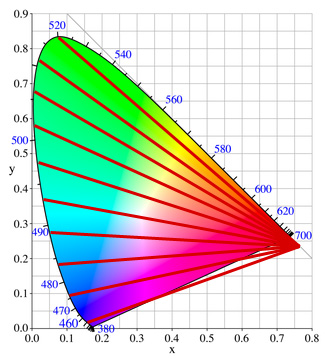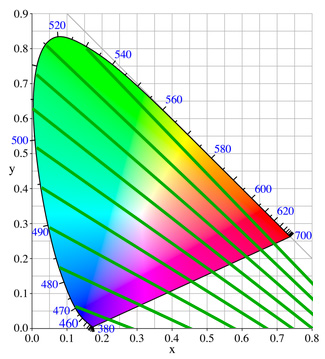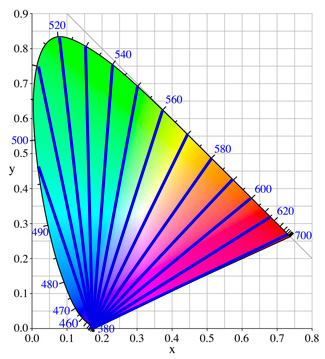How does it work?
Scientific background of the color blind test
The diagrams below demonstrate the colors that tend to be problematic for colorblind people. The colors in the directions of the lines may be hard for them to discriminate from one another. Based on the color of its lines, each diagram corresponds to one of the three main color vision deficiencies. The with red lines corresponds to protanopia (“red” blindness), the green lines to deuteranopia (“green” blindness), and the blue lines to tritanopia (“blue” blindness). The lines are called confusion lines. For both types of red-green color blindness (deuteranopia and protanopia) the biggest confusion between colors is in the axis between red and green. On this side of the color space, the confusion lines are pointed in approximately the same direction for both types. Protanopia gets more horizontal towards the blues (this creates the different discretion in many colors between protans and deutans), but both color deficiency confusion lines are more vertically inclined towards the reds and greens. This is why the two types of colorblindness are grouped together as red-green deficiency. As shown in the diagrams, the whole color spectrum is drastically reduced for colorblind people. It is much more than just red and green (deuteranopia/protanopia) or blue and yellow (tritanopia) that are indistinguishable from other colors.
The Colorlite color vision test uses this well-known phenomenon. The colors used in the test are from the confusion lines. The red-green colors are from the color space, where the confusion lines are quite the same for both types (protan and deutan), while the purple-blue and purple-green colors are quite sensitive to differentiate them. The colors of the tritan test are in the line of the purple-red confusion lines. There is an easier explanation of the test. Example: Purple is a mix of blue and red colors of the monitor. As a consequence, if your red sensitivity is reduced (protan), the background and C shape looks similar, because the red component of the purple is reduced as well. The same for tritans just the blue sensitivity is reduced, so the background (without the blue component) will be similar to the red C shape.



The test was evaluated in a Multi-center, open, intra-individual comparative study to determine sensitivity and specificity of the test in subjects with Deutan or Protan color vision deficiencies and subjects with normal color vision as control group. Based on our research, this test (in clinical circumstances) gave a better correlation with genotypes of color vision deficiencies than the anomaloscope. Objective color vision tests should demonstrate the improvement of the color blindness correction glasses in all color segments.

